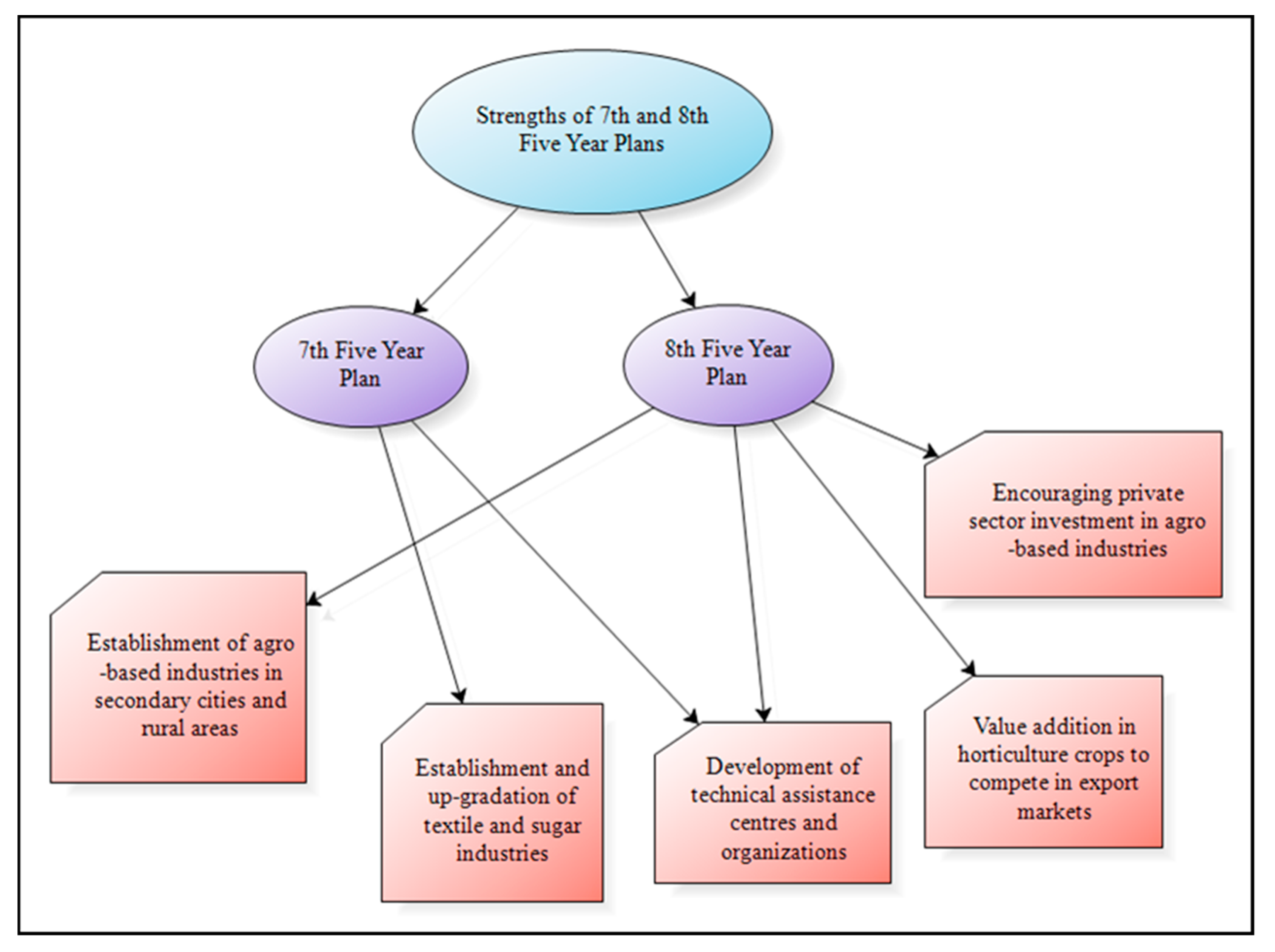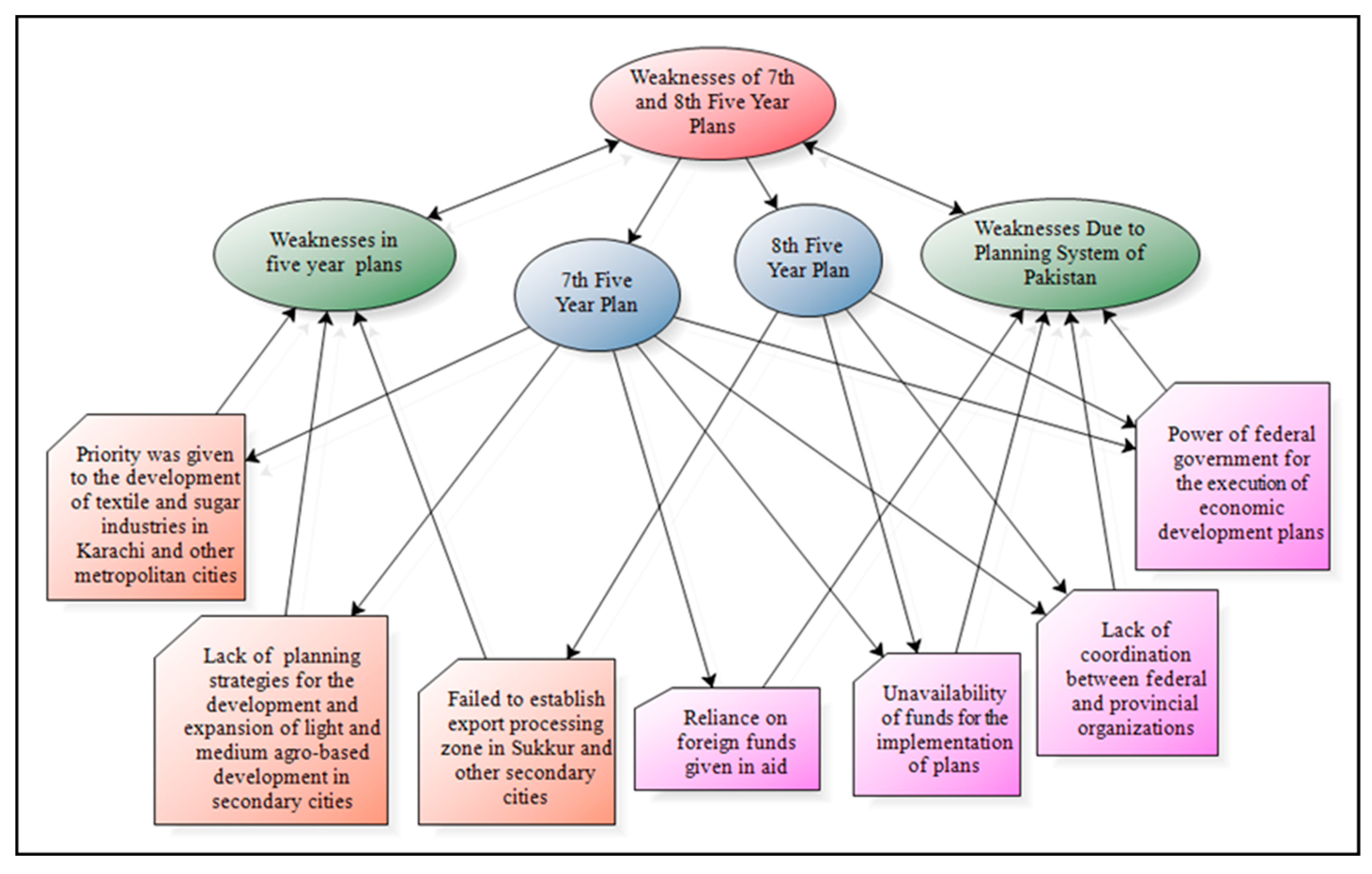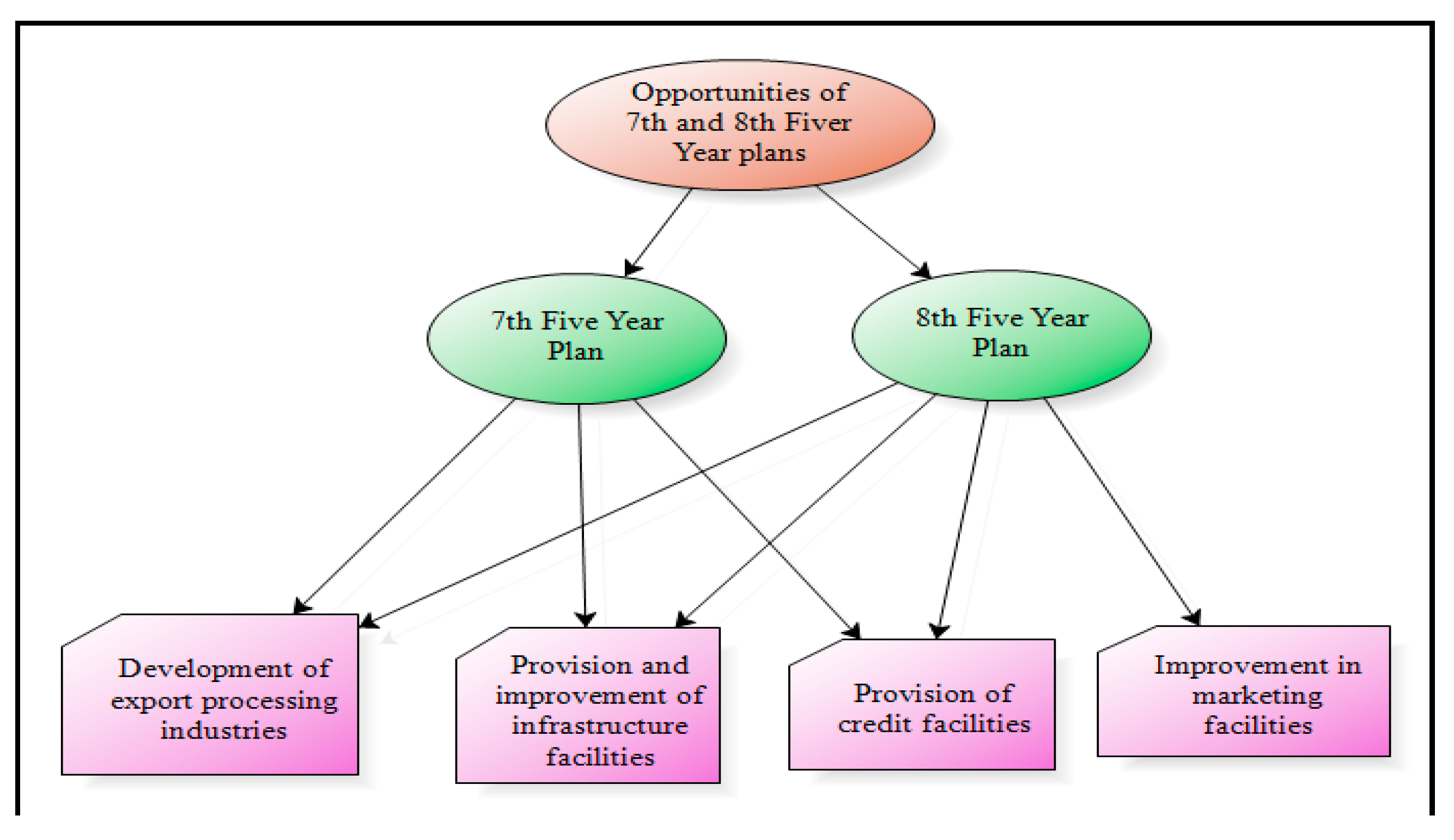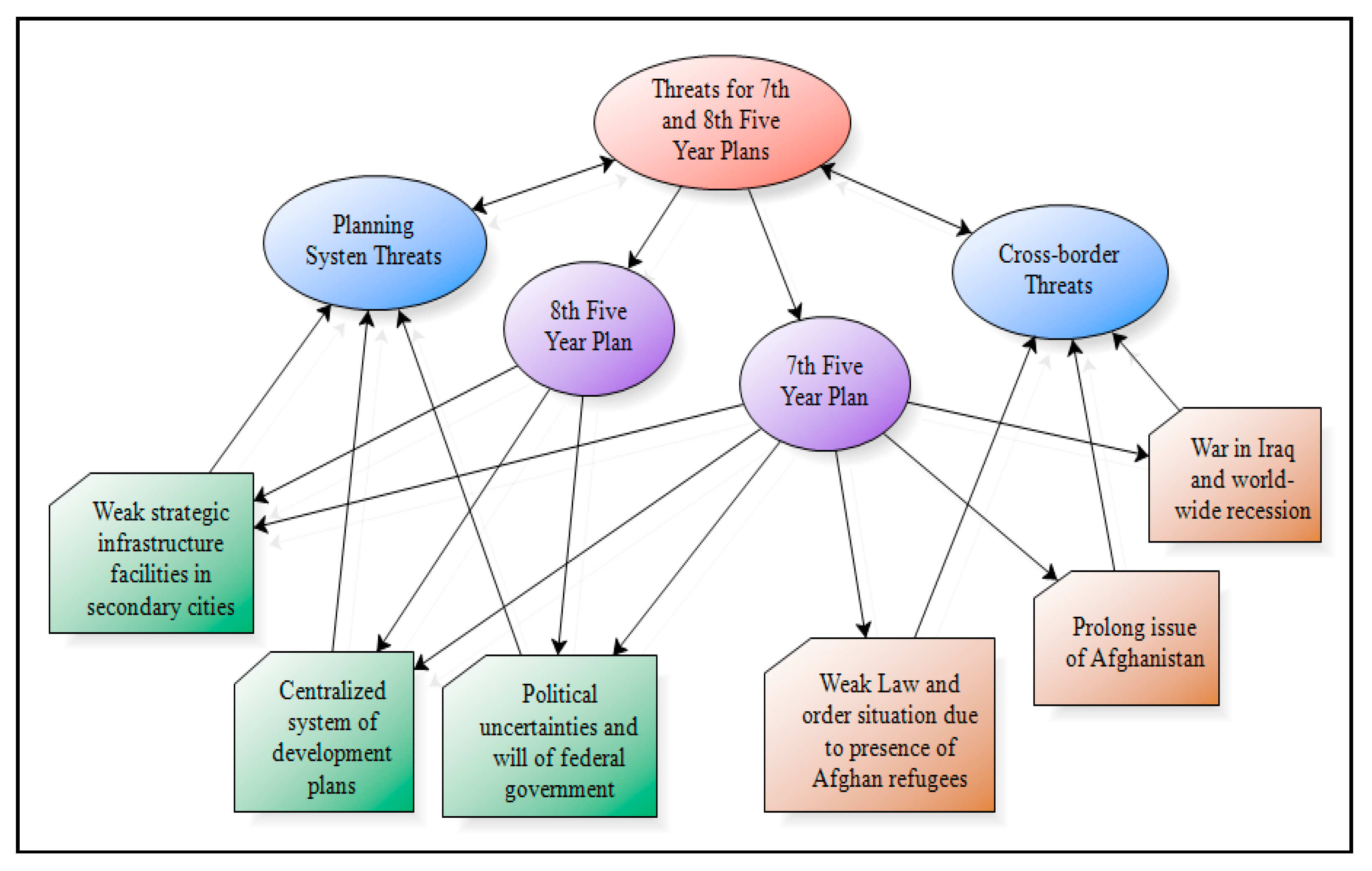National Planning Strategies for Agro-based Industrial Development in Secondary Cities of Sindh Province, Pakistan
Abstract
1. Introduction
2. Methodology
3. Data Collection
4. Data Analysis
5. Results
5.1. Seventh five-year Plan (1988–1993)
5.2. Eighth Five-Year Development Plan (1993–98)
5.3. SWOT Analysis of Seventh and Eighth Five-Year Plans
5.3.1. Strengths of Seventh and Eighth Five-Year Plans
- More than 86% interviewees claimed that the 7th five-year development plan suggested planning strategies to develop and upgrade “textile and sugar industries” and introduce value addition for sugar trade to increase local sales, as well as domestic and export (ABICase6; 20) (see Table 3 and Figure 1).
- About 87% agro-based interviewees assert that the 8th five-year plan was the only plan during 1988-1998, which had presented strategies for the processing, packaging, marketing, and grading facilities for horticultural products to meet the requirements of export markets (ABICase8; 21; 28) (shown in Table 3 and Figure 1).
- From the analysis, we came to know that 80% of agro-based officers replied that both plans suggested that it is essential to provide “technical assistance centres” to strengthen the institutions. These technical centres will help to disseminate information regarding modern technologies and will improve export (Table 3 and Figure 1). This way, the “7th and 8th five-year plans” suggested strengthening the role of Provincial Small Industrial corporations (ABICase6; 11; 18).
- The results show that 90% agro-based interviewees responded that the eighth five-year plan was the only plan, which came up with the strategy of encouraging private sector investment for the agricultural industrial sector in backward regions (ABICase22) (shown in Table 1 and Figure 1). The local and foreign investors were invited to establish export industries (ABICase3; 12).
5.3.2. Weaknesses of the 7th and 8th Plans
- More than 80% of agro-based key informants claim that sugar and textile industries have been given high priority in the 7th and 8th five-year plans as shown in Table 4 and Figure 2. The key share of the agricultural industrial development budget was also given to develop textile and sugar industries (ABICase7; 21; 30).
- According to 70% of key informants of the agro-based sector, Pakistan has a federal planning system. Therefore, all the income generated from taxes and revenues are collected by the central government (ABICase3; 5; 18; 22). In addition, provincial institutions are dependent on the central government for the sanctioning of development budget (ABICase1; 14; 30) (see Table 4 and Figure 2).
- In Pakistan, all institutions are fully dependent on the central government. Therefore, the five-year development plans are developed by federal government. The central government has authority through a law to prepare and implement five-year plans. There is an absence of an intermediate plan system at the provincial level. The provincial governments can only develop annual plans (ABICase3; 7; 30). Due to this planning gap, more than 70% of key informants replied that there are lack of communication and coordination among various provincial and central institutions (ABICase114; 25) (see Table 4 and Figure 2).
- 80% of key interviewees asserted that during the 7th five-year plan, the federal government was lacking in domestic funding and heavily relayed on foreign aid (see Table 4 and Figure 2). Due to this reason, almost all the suggested programs of development plans were executed later than their actual time (ABICase7; 11; 29).
- Mostly, the central government allocated and released development funds for specific programs which are in their favor. This was claimed by more than 70% of informants as described in Table 4 and Figure 2. Thus, during the 8th five-year plan, the development programs in Sindh were not implemented due to unwillingness of the federal government (ABICase9; 16; 23).
5.3.3. Opportunities for Agricultural Industrial Growth
- 80% of key interviewees replied that “7th and 8th five-year plans” show strategies to develop export-oriented processing units to increase foreign exchange earnings as given in Table 5 and Figure 3. In this way, the 7th five-year plan had proposed to establish institutions to guide industrialists about suitable export design and modern technologies (ABICase10; 19). The 8th five-year plan had also suggested, for the establishment of export processing zones, to pursue foreign investors, increase employment opportunities, produce export-oriented products, promote technology transfers, and get more foreign exchange earnings through value addition in secondary cities (ABICase5; 18; 26).
- More than 70% of agro-based key interviewees claimed that 7th and 8th five-year plans have offered strategies to provide ample infrastructure services for agricultural-based industries as presented in Table 5 and Figure 3. Thus, both five-year plans contain plans to design and develop urban areas with more facilities and services. Business centers, market roads, and utility services must be provided in industrial areas (ABICase1; 3; 15; 30).
- 86% of key interviewees replied that both development plans contain strategies to give credit services to agricultural industrial development (see Table 5 and Figure 3). Thus, both 7th and 8th five-year plans had suggested developing industrial credit cells to provide loans to agro-based and cottage industry investors (ABICase15; 17; 30).
5.3.4. Threats for Seventh and Eighth Five-Year Plans
6. Discussion
7. Conclusions
Author Contributions
Funding
Conflicts of Interest
References
- Recasens, X.; Alfranca, O.; Maldonado, L. The adaptation of urban farms to cities: The case of the Alella wine region within the Barcelona Metropolitan Region. Land Use Policy 2016, 56, 158–168. [Google Scholar] [CrossRef]
- Edoumiekumo, S.; Audu, N. The impact of agriculture and agro-based industries on economic development in Nigeria: An econometric assessment. J. Res. Natl. Dev. 2009, 7, 100–101. [Google Scholar]
- Da Silva, C.A. Agro-Industries for Development; CABI: Wallingford, UK, 2009. [Google Scholar]
- Partridge, M.; Olfert, M.R.; Alasia, A. Canadian cities as regional engines of growth: Agglomeration and amenities. Can. J. Econ. 2007, 40, 39–68. [Google Scholar] [CrossRef]
- Wu, J.; Gopinath, M. What causes spatial variations in economic development in the United States? Am. J. Agric. Econ. 2008, 90, 392–408. [Google Scholar] [CrossRef]
- Berdegué, J.A.; Carriazo, F.; Jara, B.; Modrego, F.; Soloaga, I. Cities, territories, and inclusive growth: Unraveling urban–rural linkages in Chile, Colombia, and Mexico. World Dev. 2015, 73, 56–71. [Google Scholar] [CrossRef]
- Song, L. Southeast Asian Secondary Cities: Frontiers of Opportunity and Challenges; MIT, Community Innovators Lab (CoLab): Cambridge, MA, USA, 2013. [Google Scholar]
- Brain, R. Managing Systems of Secondary Cities, Policy Responses in International Development; Cities Alliance: Washington, DC, USA, 2014. [Google Scholar]
- Rondinelli, D.A. Dynamics of growth of secondary cities in developing countries. Geogr. Rev. 1983, 73, 42–57. [Google Scholar] [CrossRef]
- Juan, E. Foreword onManaging System of Secondary Cities: PolicyResponses in InternationalDevelopment; Cities Alliance: Brussels, Belgium, 2014; p. 2. Richardson, H.W. In City Size and National Spatial Strategies in Developing Countries; The World Bank: Washington, DC, USA, 1977. [Google Scholar]
- Al-Naser, A.S. The Need for Developing Policies and Guidelines for Future Growth of Secondary Cities in Saudi Arabia: The Case of Hofuf. Ph.D. Thesis, University of Pennsylvania, Philadelphia, PA, USA, 1989. [Google Scholar]
- Vachal, K. Economic Growth of Nonmetropolitan and Agricultural Cities. Ph.D. Thesis, George Mason University, Fairfax, VA, USA, 2005. [Google Scholar]
- MacDonald, S. Secondary cities are an untapped resource. Penang Mon. 2012, 21. [Google Scholar]
- Kalwar, S.; Dali, M.; Hassan, N. Development Framework for Agro-Based Industries in Secondary Cities of Sindh Province, Pakistan: SWOT Analysis of Ten-Year Perspective and Medium-Term Development Framework Plans. Sustainability 2018, 10, 1197. [Google Scholar] [CrossRef]
- Purohit, P.; Munir, T.; Rafaj, P. Scenario analysis of strategies to control air pollution in Pakistan. J. Integr. Environ. Sci. 2013, 10, 77–91. [Google Scholar] [CrossRef]
- Subhan, S.; Ahman, E. The economic and demographic effects on housing tenure choice in Pakistan. Am. Int. J. Contemp. Res. 2012, 2, 15–24. [Google Scholar]
- Ali, A.; Erenstein, O. Assessing farmer use of climate change adaptation practices and impacts on food security and poverty in Pakistan. Clim. Risk Manag. 2017, 16, 183–194. [Google Scholar] [CrossRef]
- Bureau of Statistics. Statistical Yearbook; Bureau of Statistics: Shenzhen, China, 2012. [Google Scholar]
- Mohsin, M. Rapid Urban Growth and Change in Urban and Municipal Limits of Bahawalpur City, Pakistan: A Spatio-Periodical Discourse. J. Basic Appl. Sci. 2015, 11, 528–538. [Google Scholar]
- Pike, A.; Rodríguez-Pose, A.; Tomaney, J. Local and Regional Development; Routledge: Abingdon-on-Thames, UK, 2016. [Google Scholar]
- Sotarauta, M. Leadership and the City: Power, Strategy and Networks in the Making of Knowledge Cities; Routledge: Abingdon-on-Thames, UK, 2015. [Google Scholar]
- Siddiqui, K. Experiences of capitalism in India and Pakistan. Res. Appl. Econ. 2011, 3, 1–48. [Google Scholar] [CrossRef]
- Mamoon, D.; Ahsan, M.R. Short term versus long term economic planning in Pakistan: The dilemma. J. Econ. Libr. 2017, 4, 30–40. [Google Scholar]
- Knox, P.L.; Taylor, P.J. World Cities in a World-System; Cambridge University Press: Cambridge, UK, 1995. [Google Scholar]
- Bolay, J.-C.; Rabinovich, A. Intermediate cities in Latin America risk and opportunities of coherent urban development. Cities 2004, 21, 407–421. [Google Scholar] [CrossRef]
- Williams, J.F. The role of secondary cities in rapidly industrializing countries: The example of Kaohsiung, Taiwan. In Challenges to Asian Urbanization in the 21st Century; Springer: Berlin/Heidelberg, Germany, 2004; pp. 225–241. [Google Scholar]
- Roberts, B.; Hohmann, R. The Systems of Secondary Cities: The Neglected Drivers of Urbanising Economies; CIVIS Notes Series No. 7: Sharing Knowledge and Learning from Cities; The World Bank: Washington, DC, USA, 2014. [Google Scholar]
- Marais, L.; Nel, E.; Donaldson, R. Secondary Cities and Development; Routledge: Abingdon-on-Thames, UK, 2016. [Google Scholar]
- Christiaensen, L.; Todo, Y. Poverty Reduction during the Rural-Urban Transformation—The Role of the Missing Middle; The World Bank: Washington, DC, USA, 2013. [Google Scholar]
- Saunders, M.; Lewis, P.; Thornhill, A. Research for Business Students; Pearson Education Limited: Harlow, UK, 2009. [Google Scholar]
- Robsson, C. Real World Research a Resource for Social Scientist and Practitioner; Blackwell Publishing Ltd.: Oxford, UK, 2002. [Google Scholar]
- Higgs, J.; Titchen, A.; Horsfall, D.; Bridges, D. Creative Spaces for Qualitative Researching: Living Research; Springer Science & Business Media: Berlin/Heidelberg, Germany, 2012; Volume 5. [Google Scholar]
- Cohen, D.J.; Crabtree, B.F. Evaluative criteria for qualitative research in health care: Controversies and recommendations. Ann. Family Med. 2008, 6, 331–339. [Google Scholar] [CrossRef]
- Lichtman, M. Qualitative Research in Education: A User’s Guide; Sage: Newcastle upon Tyne, UK, 2012. [Google Scholar]
- Boyce, C.; Neale, P. Conducting in-Depth Interviews: A Guide for Designing and Conducting in-Depth Interviews for Evaluation Input; Pathfinder International: Waterton, MA, USA, 2006. [Google Scholar]
- Bowen, G.A. Document analysis as a qualitative research method. Qual. Res. J. 2009, 9, 27–40. [Google Scholar] [CrossRef]
- Berg, B.; Lune, H. Qualitative Research Methods for the Social Sciences; Pearson: Boston, MA, USA, 2004; Volume 5. [Google Scholar]
- Karppi, I.; Kokkonen, M.; Lähteenmäki-Smith, K. SWOT-Analysis as a Basis for Regional Strategies; Nordregio: Stockholm, Sweden, 2001. [Google Scholar]
- Piaw, C.Y. Mastering Research Methods; McGraw-Hill: Kuala Lumpur, Malaysia, 2012. [Google Scholar]
- Tsenkova, S. SWOT Analysis of Sofia’s Economy, Infrastructure and Spatial Planning Issues; World Bank, Infrastructure Sector Unit, Europe and Central Asia Region: Washington, DC, USA, 2002. [Google Scholar]
- Tsenkova, S. Venturing into unknown territory: Strategic spatial planning in post-communist cities. Urbani Izziv 2011, 22, 83–99. [Google Scholar] [CrossRef]
- Humphrey, S.A. “SWOT Analysis for Management Consulting”, SRI Alumni Association Newsletter, December 2005. Available online: http://www.sri.com/sites/default/files/brochures/dec-05.pdf (accessed on 20 November 2019).
- Bazeley, P.; Jackson, K. Qualitative Data Analysis Using NVivo; Sage Publication Ltd.: London, UK, 2007. [Google Scholar]
- Kluge, S. Empirically grounded construction of types and typologies in qualitative social research. Forum Qual. Soc. Res. Soz. 2000, 1. [Google Scholar] [CrossRef]
- White, M.D.; Marsh, E.E. Content analysis: A flexible methodology. Libr. Trends 2006, 55, 22–45. [Google Scholar] [CrossRef]
- Stuckey, H.L. The second step in data analysis: Coding qualitative research data. J. Soc. Health Diabetes 2015, 3, 007–010. [Google Scholar] [CrossRef]
- Planning Commission. Seventh Five-Year Development Plan (1988–93) and Perspective Plan (1988–2003); Planning Commission, Government of Pakistan: Islamabad, Pakistan, 1988.
- Planning Commission. Eighth Five-Year Development Plan (1993–98); Planning Commission, Government of Pakistan: Islamabad, Pakistan, 1994.
- Planning Commission. Ten-Year Perspective Plan (2001–11) and Three-Year Development Programme (2001–04); Planning Commission, Government of Pakistan: Islamabad, Pakistan, 2001.




| Strengths | Weaknesses |
|
|
| Opportunities | Threats |
|
|
| Strengths | Weaknesses |
|
|
| Opportunities | Threats |
|
|
| Strengths | Development Plans | Number of Respondents | %age (n x100/30) |
|---|---|---|---|
| Development of agricultural industries in rural areas and secondary cities | 7th Plan | -- | -- |
| 8th Plan | 21 | 70 | |
| Development and up-gradation of sugar and textile industries | 7th Plan | 27 | 90 |
| 8th Plan | -- | -- | |
| Value addition in horticulture crops to compete in export markets | 7th Plan | -- | -- |
| 8th Plan | 26 | 86.67 | |
| Development of technical assistance centers and organizations | 7th Plan | 28 | 93.33 |
| 8th Plan | 24 | 80 | |
| Encouraging private sector investment in agro-based industries | 7th Plan | -- | -- |
| 8th Plan | 27 | 90 |
| Weaknesses (basic-Theme) | Weaknesses (Sub-Theme) | Development Plans | Number of Respondents | %age (n x100/30) |
|---|---|---|---|---|
| Weaknesses in 7th and 8th five-year development plans for agricultural-based industrial growth | High Priority for the development of both “textile and sugar” industrial sectors in metropolitan cities | 7th Plan | 25 | 83.33 |
| 8th Plan | -- | -- | ||
| Poor planning policies for the growth of light and medium agricultural industries | 7th Plan | 24 | 80 | |
| 8th Plan | -- | -- | ||
| Failed to establish export processing zone in Sukkur and other secondary cities | 7th Plan | -- | -- | |
| 8th Plan | 27 | 90 | ||
| Weaknesses in the planning system of the country | Preparation and execution of economic plans authority belongs to the central government | 7th Plan | 21 | 70 |
| 8th Plan | 24 | 80 | ||
| Less coordination among central and provincial institutions | 7th Plan | 22 | 73.33 | |
| 8th Plan | 21 | 70 | ||
| Reliance on foreign funding given in aid | 7th Plan | 24 | 80 | |
| 8th Plan | -- | -- | ||
| Absence of economic funds to implement plans | 7th Plan | 21 | 70 | |
| 8th Plan | 24 | 80 |
| Opportunities (Sub-Themes) | Development Plans | No of Respondents | Percentage (n x100/30) |
|---|---|---|---|
| Growth of processing industries for export | 7th Plan | 24 | 80 |
| 8th Plan | 29 | 96.67 | |
| Delivery and expansion of infrastructure services | 7th Plan | 21 | 70 |
| 8th Plan | 24 | 80 | |
| Facilities for credit services | 7th Plan | 27 | 90 |
| 8th Plan | 26 | 86.67 | |
| Improvement in marketing facilities | 7th Plan | -- | -- |
| 8th Plan | 23 | 76.67 |
| Threats (Main-Themes) | Threats (Sub-Themes) | Development Plans | No of Respondents | Percentage (n x100/30) |
|---|---|---|---|---|
| Planning system threats for 7th and 8th five-year development plans | Weak strategic infrastructure facilities in secondary cities | 7th Plan 8th Plan | 23 22 | 76.67 73.33 |
| The centralized system of development plans | 7th Plan | 23 | 76.67 | |
| 8th Plan | 24 | 80 | ||
| Political uncertainties and will of the federal government | 7th Plan | 23 | 76.67 | |
| 8th Plan | 26 | 86.67 | ||
| Cross-border threats for 7th and 8th five-year development plans | War in Iraq and worldwide recession | 7th Plan 8th Plan | 23 -- | 76.67 -- |
| Continuing issue of Afghanistan war | 7th Plan | 22 | 73.33 | |
| 8th Plan | -- | -- | ||
| Afghan refugees are the main cause of poor law and order situation in Pakistan | 7th Plan | 25 | 83.33 | |
| 8th Plan | -- | -- |
© 2019 by the authors. Licensee MDPI, Basel, Switzerland. This article is an open access article distributed under the terms and conditions of the Creative Commons Attribution (CC BY) license (http://creativecommons.org/licenses/by/4.0/).
Share and Cite
Kalwar, S.; Sahito, N.; Memon, I.A.; Hwang, J.; Mangi, M.Y.; Lashari, Z.A. National Planning Strategies for Agro-based Industrial Development in Secondary Cities of Sindh Province, Pakistan. Sustainability 2019, 11, 7066. https://doi.org/10.3390/su11247066
Kalwar S, Sahito N, Memon IA, Hwang J, Mangi MY, Lashari ZA. National Planning Strategies for Agro-based Industrial Development in Secondary Cities of Sindh Province, Pakistan. Sustainability. 2019; 11(24):7066. https://doi.org/10.3390/su11247066
Chicago/Turabian StyleKalwar, Saima, Noman Sahito, Irfan Ahmed Memon, Jinsoo Hwang, Muhammad Yousif Mangi, and Zulfiqar Ali Lashari. 2019. "National Planning Strategies for Agro-based Industrial Development in Secondary Cities of Sindh Province, Pakistan" Sustainability 11, no. 24: 7066. https://doi.org/10.3390/su11247066
APA StyleKalwar, S., Sahito, N., Memon, I. A., Hwang, J., Mangi, M. Y., & Lashari, Z. A. (2019). National Planning Strategies for Agro-based Industrial Development in Secondary Cities of Sindh Province, Pakistan. Sustainability, 11(24), 7066. https://doi.org/10.3390/su11247066








